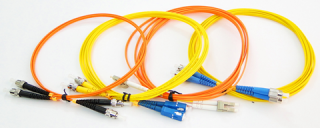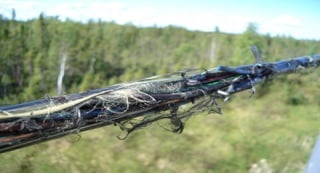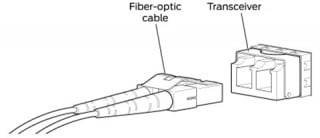Patch Cable Selection Guide to Fiber Optic Transceivers
petak , 13.05.2016.Nowadays, a huge number of bandwidth-hunger devices are housed in data centers, like clustered storage systems, backup devices, and various servers, which are all connected by networking equipment. These devices need reliable and scalable cabling structure for high performance and flexibility. For some large- or middle-sized enterprises, their billion-dollar business lie in the suitable deployment of fiber patch cords and fiber optic transceivers. Since there are many kinds of patch cables available in the market for transceiver modules to promote data transmission in enterprises’ data centers, it seems a little difficult to choose the right kind for such transceivers. This text tackles this issue and provides some selection guide.
When delve into this topic, it’s imperative to have a basic understanding of the fiber optic transceiver.
Fiber Optic Transceiver Basics
Fiber optic transceiver, just as its name replies, is a self-contained component that can both transmit and receive signals. In most cases, this transceiver is plugged in devices such as routers or network interface cards which offer one or more transceiver module slot. In its whole signal transmission process, the transmitter takes an electrical input and converts it to an optical output from a laser diode or LED. The light from the transmitter is coupled into the fiber with a connector and is transmitted through the fiber optic cable plant. The light from the end of the fiber is coupled to a receiver where a detector converts the light into an electrical signal which is then conditioned properly for use by the receiving equipment.
According to different protocols, a wide range of optical transceivers are designed to support different data rates, including Gigabit SFP transceiver, 10G SFP+ transceiver, 40G QSFP+, etc..Take MGBBX1 for example, this Cisco 1000BASE-BX-U SFP is designed to be applied in Gigabit Ethernet (GbE) applications.
Fiber Patch Cord Details
Fiber optic patch cord, also called fiber jumper or fiber optic patch cable, consists of fiber optic cable terminated with different connectors on the ends. It’s typical application includes computer work station to outlet and patch panels or optical cross connect distribution center. While selecting patch cord, it’s recommended to take on from the following aspects, fiber cable mode, cable structure, connector types and so on.
Single-mode/Multi-mode Patch Cord
It’s known that fiber patch cords can be classified into single-mode and multi-mode fiber patch cord based on cable mode used. Single-mode patch cords, usually in yellow color, are with 9/125 fiber glass and has only one pathway for signal transmission, while multi-mode ones, often in orange, are with OM1 62.5/125 or OM2 50/125 fiber glass, and allow multiple pathways and several wavelengths of light to be transmitted with the large core.
Simplex/Duplex Patch Cord
According to the cable structure, patch cord can be divided into simplex and duplex versions. Simplex, also known as single strand, patch cable has one fiber, while duplex cable has two fibers joined with a thin web. Both simplex and duplex patch cords are available in single-mode or multi-mode versions. Because simplex patch cord has only one fiber link, its typically deployed for applications that only require one-way data transfer. For those applications, like fiber switches and servers, it’s advised to select duplex fiber optic cable for simultaneous and bidirectional data transfer. Additionally, there is also ribbon fan-out cable assembly (ie. one end is ribbon fiber with multi fibers and one ribbon fiber connector such as MTP connector (12 fibers), the other end is multi simplex fiber cables with connectors such as ST, SC, LC, etc.).
Patch Cord With Different Connectors
By connector type standard, fiber patch cord can also be divided. For instance, LC fiber patch cable is named as it is with LC connector. Similarly, there are SC, ST, FC, MT-RJ, E2000, MU and MPO/MTP fiber patch cables. Additionally, there are PC, UPC, APC type fiber patch cords, which are differentiated from the polish of fiber connectors.
How to Select Right Patch Cord for Transceiver?
After respective introduction to fiber optic transceiver and fiber patch cord, let’s go to the core issue—to choose the suitable cable type for transceivers.
In this part, I will take Cisco transceiver modules for example. For example, I need the suitable cable type for these two Cisco GbE transceiver modules, GLC-EX-SMD and MGBLX1. Then how to choose the right type? According to “Cisco Gigabit Ethernet Transceiver Modules Compatibility Matrix”, GLC-EX-SMD is the 1000BASE-EX SFP module that works through single-mode fiber (SMF) with LC duplex, and MGBLX1 is the 1000BASE-LX SFP module also for SMF with LC duplex. In such a case, since both two modules operate on SMF with LC connector, what I need is the with LC-LC duplex single-mode patch cable.
Conclusion
The above-mentioned example just lists one patch cable type for fiber optic transceivers. There are several commonly-aused patch cable types: LC-LC Simplex 9/125 Single-mode Fiber Patch Cable, LC-SC Duplex 9/125 Single-mode Fiber Patch Cable, LC-LC Duplex OM1 62.5/125 Multi-mode Fiber Patch Cable, ect.. Fiberstore supplies various kinds of high-quality patch cords for transceiver modules. You can visit Fiberstore for more information about patch cords.
Oznake: fiber patch cords, fiber optic transceiver, SFP, MGBBX1, MGBLX1
komentiraj (0) * ispiši * #
Three Factors That May Destroy Fiber Optic Cables
srijeda , 06.04.2016.Fiber optic cable, which has become the essential component of nearly all modern computer and communications systems nowadays, has been deployed all over the world. Where there is a city, there are thousands of fiber optic cables connecting people to the networking systems. Without them, it’s hard get the information in real time. But there is a problem that once the fiber optic cable is damaged or cut, it may cause a big loss because of the network disruption. And we know that fiber optic cable is made up of pure glass, in some cases, it may be very fragile. This article gives you three factors that may destroy the cables.
Environment
The environment is the first thing you should take into consideration. Because in the extreme weather conditions, such as hurricanes, mud slides, flood and ice storms, ect., fiber optic cable would suffer great damage. If water enters, a splice enclosure can freeze, then this will crush the fiber strands and leave you with a costly network outage. Additionally, lightning is also a factor to destroy fiber cables. When lightning strikes the ground, it will search for the best conductor available, even if it’s underground. If that happens to be the armor or trace-wire of your fiber cable, then damage to the cable sheath and even the fiber itself is very likely.
Human’s Destruction
Here human refers to the people who steal the fiber. They cut the fiber thinking it has value and can be sold in pieces. The most classical event is that a 75 year-old woman in Georgia (country in Asia) was digging with her spade, looking for copper, which she wanted to sell for scrap, when she accidentally cut the fiber optic cable that provided internet to 90% of Armenia. It is ridiculous. It is fiber but not copper! In addition, people vandalize the fiber cable in other ways, e.g. for gun practice. This especially happens in the rough parts of town which makes the cable repair work become dangerous. Furthermore, land disputes which cause artificial malicious damage of fiber are also a fiber damage reason.
Animals Chew & Bite
We can try to reason with humans and publicize our buried fiber cable, but there is nothing we can do about the cable damage causing by animals. Squirrel, a furry little nut eater, seems to be deeply fond of fiber cable sheathing besides nuts. We even doubt that the cable manufacturers of using peanut oil in the sheathing. Since they have a life-long drive to gnaw, squirrel is often responsible for extensive damage to fiber optic cable. Even metal armored cable can get cut in two by this furry critter. In addition, undersea cables aren’t exempt from cuts. Because there is another kind of animal under ocean that is likely to bite cables. It is shark. Why shark would like to eat fiber cables? Effect by magnetic fields is one of the explanation at present. We have no idea how we can combat these wayward rodents. Now, only thing we can do is always looking for ways to improve.
Notes on the Use of Fiber Optic Cables
After mentioning three common factors that may do harm to fiber cables, there goes the basic information about the use of fiber cables and their related fiber optic transceivers.
Fiber cables are used as the transmission medium of fiber optic transceivers for high data-rate transmission in gigabit applications, with distance reaching from only several hundred meters on multi-mode fibers (MMFs) to 10km, 20km, 40km, 80km on single-mode fibers (SMFs). Take Gigabit Ethernet (GbE) applications for example, when 1000BASE-LX SFPs (eg. MGBLX1) work through SMFs, 10km link length is made possible; and 1000BASE-SX SFPs (eg. MA-SFP-1GB-SX) operates via OM2 (MMF), the possible distance reach is 550m. So when you choose fiber optic cables for fiber systems, it’s necessary to figure out what the distance reach is required first, and then you can deploy the right fiber cable type for different applications.
Conclusion
So after you obtain a good understanding of the three factors that may destroy the fiber optic cables, you must master how to protect the cables. Now, waterproof fiber cables, armored fiber cables and the other outdoor cables which are designed to protect fibers in a harsh application environment are widely used in this field. You can buy these fiber optic cable as well as the related fiber optic transceivers (MGBLX1, MA-SFP-1GB-SX, etc.) in Fiberstore which are really reliable. Any questions, please let me know.
Oznake: fiber optic cable, SMFs, MGBLX1, MMFs, MA-SFP-1GB-SX
komentiraj (0) * ispiši * #
Transceiver Selection Guide for Your Networking Use
četvrtak , 24.03.2016.Thanks to the advances made in fiber optical technologies, fiber solutions have been deployed in ever-increasing applications where high-speed and high-performance data transmission is needed. They outweigh the copper solutions in such aspects as higher bandwidth, longer distances and Electromagnetic interference (EMI) immunity. Transceivers, one of the key components required in such fiber connections for high networking performance, have experienced the never-ceasing industrial designs, from lower port density to higher, from the standard modules to the final hot-pluggable ones, to meet the ever more flexible networking infrastructure.
There is a broad selection of hot-pluggable transceiver modules available for fiber networking use, and you may feel a little confused about how to select the correct transceivers for your networking transmission. In this article, I will illustrate different aspects of transceivers that need to be known before choosing a transceiver.
Transceiver Basics
Before giving guidance to transceiver selection, it’s necessary to know the basics of transceiver. Transceiver is a combination of a transmitter and a receiver in a single package, while they function independently for bidirectional communication. Typically, a fiber optic transceiver converts the incoming optical signal to electrical and the outgoing electrical signal to optical. More specifically, the transmitter takes an electrical input and converts it to an optical output from a laser diode or LED. The light from the transmitter is coupled into the fiber with a connector and is transmitted through the fiber optic cable plant. The light from the end of the fiber is coupled to a receiver where a detector converts the light into an electrical signal which is then conditioned properly for use by the receiving equipment.
Here go the several aspects of transceivers that are helpful in your purchasing.
Form-factor
Multi-source agreements (MSAs) between different equipment vendors specify guidelines for electrical and optical interfaces, mechanical dimensions and electro-magnetic specification of a transceiver. The equipment vendors follow these MSA defined values for designing their systems to ensure interoperability between interface modules. The form-factor or the MSA-type is needed so that the transceiver can mechanically and electrically fit into a given switch, router, etc. Transceiver MSAs define mechanical form factors including electric interface as well as power consumption and cable connector types. There are various MSA types: SFP (eg. MGBSX1), SFP+, XFP, CFP, CFP2, CFP4, QSFP and so on.
Transmission Media
Transceivers can work over single-mode fiber (SMF), multi-mode fiber (MMF), and copper. In different Ethernet applications, media can achieve different link lengths when combined with transceivers. Take Gigabit Ethernet (GbE) applications for example, single-mode transceivers can have a transmission distance of 5km to 120km, while multi-mode transceivers are defined to have the maximum reach of 55om, with copper solution establishing even fewer link length at 25m. Take MGBLX1 for example, this Cisco compatible 1000BASE-LX SFP works through SMF for 10km reach.
Power Budget
The transceiver power budget is the difference between transmitter launch power and receiver sensitivity and has to be 2-3dB larger (Margin) than the measured link loss. If the link loss cannot be measured, it has to be calculated. Therefore transmission distance [km], the number of ODFs, patches and passive optical components (Muxes) have to be known. Common values for power budget are <10, 14, 20, 24, 28, >30dB.
If you’re seeking high-speed data carrier, transceivers can help accomplish goals. By transmitting data at 10Gbit/s, 40Gbit/s, 100Gbit/s or 12940Gbit/s, they can ensure that data arrives quickly. Transceiver modules that are capable of handling fast speeds can help with downloads and high and low bandwidth video transmission.
Conclusion
Transceivers are instrumental in ensuring that the data is transmitted securely, expeditiously, and accurately across the media. Choosing the right type of transceiver for your network is not always easy, but knowing above discussed parameters beforehand helps you narrow it down to a few transceivers. Fiberstore offers a sea of transceiver modules which are fully compatible with major brands, like the above mentioned MGBSX1 and MGBLX1, the Cisco compatible transceiver modules. For more information about transceiver modules, you can visit Fiberstore.
Oznake: transceivers, MSAs, SFP, MGBSX1, compatible transceiver modules, MGBLX1
komentiraj (0) * ispiši * #








